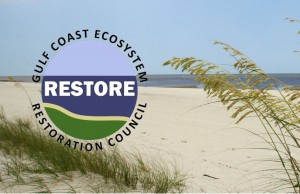
On April 20, 2010, a massive explosion caused approximately 134 million gallons of oil to spill from the Deepwater Horizon drilling rig into the Gulf of Mexico in the largest environmental disaster in American history. The oil flowed for 87 days, affecting 68,000 square miles of ocean, before being capped on July 15, 2010. For months, thousands of people worked to stop the flow of oil and protect the shorelines, wildlife, and coastal communities.
In July 2012, in response to the Deepwater Horizon oil spill and other environmental challenges in the Gulf Coast region, Congress passed the Resources and Ecosystems Sustainability, Tourist Opportunities, and Revived Economies of the Gulf Coast States Act (RESTORE Act). The RESTORE Act:
- Created a Gulf Coast Restoration Trust Fund;
- Outlined a structure for use of the Trust Fund; and
- Established the Gulf Coast Ecosystem Restoration Council (GCERC), which is comprised of the Governors of the States of Alabama, Florida, Louisiana, Mississippi, and Texas; the Secretaries of the U.S. Departments of Agriculture, Army, Commerce, Homeland Security, and the Interior; and the Administrator of the U.S. Environmental Protection Agency.
As part of its mission to support GCERC, VMSI staff have been actively engaged in the development of GCERC’s electronic grants management system since 2014. The Restoration Assistance and Award Management System—or RAAMS—was launched and began accepting grant and interagency agreement applications in early 2016. VMSI took the lead role in designing, configuring, and testing the system prior to launch and continues to develop and expand system capabilities in advance of anticipated client needs. As part of this ongoing effort, VMSI actively administers the Web-based RAAMS component and works closely with GCERC staff to ensure that RAAMS meets Federal requirements and program needs, eliminates redundancy, and provides an intuitive end-user experience. VMSI personnel coordinate the deployment of patches and software updates, test updates for bugs and compatibility with existing data prior to production deployment, develop custom web forms to capture data elements required for various grant and interagency agreement processes, construct queries and reports that enable GCERC staff to quickly access electronic data, and continually refine the process flows and tasks that drive public user and staff actions within the system. We are proud to serve such a great cause, helping to truly restore nature to its beautiful, intended state.
